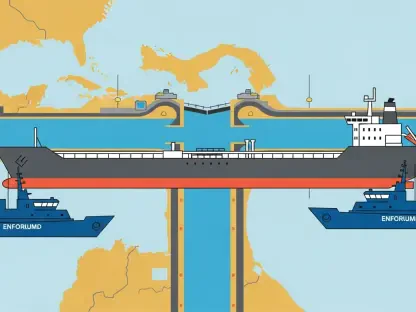In an era where climate change demands urgent action, businesses are under unprecedented scrutiny to accurately measure and reduce their carbon emissions, facing pressure from regulators, investors, and an increasingly eco-conscious public. A novel solution, known as ledger-based accounting, has emerged as a potential game-changer, promising to revolutionize how companies track and manage their environmental impact. Unlike traditional frameworks that often result in inconsistent data and overlapping counts, this innovative system treats emissions as liabilities that can be traced and transferred through the supply chain, mirroring the precision of financial transactions. At its core, it seeks to bring clarity and accountability to a process long plagued by ambiguity. Spearheaded by a coalition of industry leaders, this approach could redefine corporate sustainability strategies, but its success hinges on overcoming significant technical and logistical challenges. As the world races to meet ambitious climate goals, the question looms: could this be the breakthrough needed to align business practices with planetary needs? This exploration delves into the mechanics of ledger-based systems, the driving forces behind their adoption, and the hurdles that must be cleared for them to reshape carbon tracking on a global scale.
Unpacking the Flaws of Traditional Carbon Accounting
The current benchmark for emissions reporting, the Greenhouse Gas (GHG) Protocol, has long served as the foundation for corporate environmental accountability, categorizing emissions into three scopes—direct (Scope 1), indirect from energy use (Scope 2), and other indirect emissions from supply chains (Scope 3). Despite its widespread adoption, the framework faces sharp criticism for systemic issues that undermine its effectiveness. A primary concern is the prevalence of double counting, where emissions are reported by multiple entities along a value chain, leading to inflated totals and skewed data. Additionally, the reliance on estimates rather than primary data often results in inconsistencies, making it difficult to compare results across companies or industries. Annual reporting cycles further compound the problem, as they fail to provide the real-time insights needed for agile decision-making in a fast-moving business landscape. With regulatory demands intensifying, particularly around the notoriously complex Scope 3 emissions, these shortcomings have become glaring liabilities, pushing the need for a more robust alternative to the forefront of corporate and policy discussions.
Beyond these technical flaws, the broader implications of an outdated system are becoming increasingly apparent as global climate policies tighten. Companies are finding it challenging to meet stringent disclosure requirements under frameworks that lack precision, risking non-compliance with emerging laws in regions like the European Union and California. The inability to accurately track supply chain emissions also hampers efforts to build trust with stakeholders, who demand transparency in sustainability claims. This growing dissatisfaction among industry leaders, coupled with the urgent need for reliable data to inform decarbonization strategies, sets the stage for innovative solutions to take center stage. The limitations of traditional methods are not just a technical inconvenience; they represent a barrier to achieving the systemic change required to address climate challenges effectively, highlighting the critical timing for a shift in approach.
The Mechanics Behind E-Ledgers Innovation
At the heart of the proposed transformation lies the E-ledgers methodology, a system that redefines emissions tracking by treating them as transferable liabilities, akin to financial entries in an accounting ledger. Conceived by academics Robert Kaplan and Karthik Ramanna, this approach assigns “E-liabilities” to each entity in a supply chain, capturing both direct emissions and those embedded in inputs from upstream suppliers. When goods or services are sold, these liabilities are passed to the buyer, creating a seamless chain of accountability from raw material extraction to end consumption. By eliminating the traditional scope divisions of the GHG Protocol, E-ledgers prevent double counting and provide a granular, transaction-based view of emissions. This shift aims to replace broad estimates with precise data, offering a clearer picture of environmental impact at every stage of production, which could fundamentally alter how businesses approach their carbon responsibilities.
The potential of E-ledgers extends beyond mere accuracy to enable dynamic, real-time tracking that aligns with the pace of modern commerce. Unlike annual reporting, which often lags behind operational realities, this system allows companies to monitor emissions as transactions occur, facilitating immediate adjustments to sourcing or production practices. Such capabilities could empower procurement teams to prioritize lower-emission suppliers, embedding sustainability into everyday business decisions. Furthermore, the methodology’s focus on product-level data offers a pathway to differentiate offerings in competitive markets, where consumer demand for transparency is on the rise. While the conceptual framework appears promising, its real-world application requires robust digital infrastructure to handle vast data flows across complex supply chains, a challenge that underscores the need for careful implementation strategies as this system gains traction.
Industry Leaders Driving the Shift
A pivotal force behind the adoption of ledger-based accounting is the Carbon Measures Coalition, comprising nineteen prominent companies from sectors such as energy, finance, and logistics, which came together in October of this year to champion the E-ledgers system. Supported by the International Chamber of Commerce, the Coalition is not merely advocating for change but actively working to operationalize it through actionable frameworks. Beginning in 2026, a Technical Expert Panel on Carbon Accounting will develop guidelines tailored to high-emission industries like steel, concrete, and chemicals, with the ambition of shifting carbon tracking from corporate-level annual reports to continuous, transaction-embedded data at the product level. This initiative reflects a bold vision to integrate emissions accountability into the fabric of commercial operations, potentially redefining industry standards for sustainability.
The Coalition’s roadmap includes pilot programs set to roll out between 2027 and 2032, targeting sectors with significant environmental footprints to test the scalability of E-ledgers. These early trials will serve as critical proof points, determining whether the system can deliver on its promise of precision and practicality across diverse operational contexts. Beyond technical development, the group aims to foster collaboration among stakeholders, including academia and civil society, to ensure the framework addresses a wide range of perspectives and challenges. Success in these efforts could position the Coalition as a catalyst for broader industry adoption, influencing how companies worldwide approach emissions management. However, the path forward depends on aligning these ambitious goals with the realities of implementation, as well as securing buy-in from regulators and smaller enterprises that may lack the resources to adapt swiftly.
Catalysts Fueling the Urgency for Change
Several converging factors are accelerating the momentum toward ledger-based carbon tracking, with regulatory pressures standing out as a primary driver. Legislation such as California’s Climate Corporate Data Accountability Act and the EU’s Corporate Sustainability Reporting Directive imposes stricter requirements on supply chain emissions disclosure, compelling companies to seek more reliable data collection methods. Additionally, mechanisms like the EU’s Carbon Border Adjustment Mechanism introduce tariffs based on product-specific emissions, necessitating precise tracking that traditional systems struggle to provide. These policies reflect a global shift toward holding corporations accountable for their full environmental impact, creating an environment where innovative solutions like E-ledgers are not just desirable but essential for compliance and competitive positioning.
Equally significant is the mounting frustration with the inaccuracies inherent in the GHG Protocol, which often relies on industry averages and broad assumptions rather than primary data. This dissatisfaction is particularly acute among leaders in high-emission sectors, who face the dual challenge of managing complex value chains and meeting stakeholder expectations for transparency. The push for real-time, transaction-level insights also aligns with market trends, as consumers and investors increasingly favor businesses that can substantiate their sustainability claims with hard evidence. Together, these dynamics create fertile ground for ledger-based systems to gain traction, offering a pathway to bridge the gap between regulatory demands and operational realities. The urgency of this transition underscores the broader recognition that outdated methods are no longer sufficient in a world racing against climate deadlines.
Potential Gains from a Ledger-Based Approach
Adopting a ledger-based system like E-ledgers holds transformative potential for how emissions are managed across industries, starting with a marked improvement in accuracy. By prioritizing primary data over estimates, this methodology ensures that emissions are counted only once as they move through the supply chain, eliminating the double-counting issues that plague traditional frameworks. This precision enables companies to build more credible sustainability reports, fostering trust among regulators, investors, and customers who demand verifiable progress toward decarbonization goals. The shift to a transaction-driven model also aligns seamlessly with emerging carbon pricing schemes and border adjustment policies, providing the detailed data needed to navigate complex compliance landscapes without guesswork.
Another compelling advantage lies in the ability to track emissions in real time, a stark contrast to the delayed feedback of annual reporting cycles. This immediacy equips businesses with actionable insights to adjust operations on the fly, whether by optimizing supply chains or rethinking production processes to curb emissions. At the product level, E-ledgers allow for direct comparisons of carbon intensity across suppliers, creating market incentives for cleaner practices as procurement decisions become tied to environmental performance. Such transparency could drive a ripple effect, encouraging upstream entities to innovate in order to remain competitive. While these benefits paint an optimistic picture, realizing them will require overcoming significant barriers, a reality that tempers enthusiasm with the need for pragmatic solutions as adoption efforts unfold.
Hurdles on the Path to Implementation
Despite the promise of ledger-based accounting, substantial challenges loom over its widespread adoption, beginning with the immense technical demands of real-time emissions tracking. Building and maintaining the digital infrastructure necessary to capture and process data across sprawling supply chains represents a daunting task, particularly for smaller companies with limited technological resources. The complexity of allocating emissions in facilities that produce multiple products—such as chemical refineries—further complicates the system’s rollout, requiring standardized methods that are yet to be fully developed. These technical hurdles underscore the need for significant investment and expertise, raising questions about the feasibility of equitable implementation across diverse business landscapes.
Beyond infrastructure, concerns around data confidentiality and accountability add layers of difficulty to the transition. Sharing detailed emissions information risks exposing sensitive production data, prompting fears of competitive disadvantage and necessitating strong legal safeguards to protect proprietary information. Additionally, the E-ledgers model of transferring liabilities to end-users sparks debate over whether it adequately holds upstream polluters accountable, especially in industries where early-stage processes contribute the bulk of emissions. Compatibility with existing standards like the GHG Protocol remains an unresolved issue, as does the lack of universal guidelines to ensure consistency. Addressing these multifaceted roadblocks will be critical for the system to move from concept to reality, demanding collaboration and innovation at every level of the supply chain.
Shaping the Future of Emissions Management
Looking ahead, the trajectory of ledger-based accounting will be shaped by the Carbon Measures Coalition’s ability to finalize a workable framework within the next two years, setting the stage for pivotal pilot programs in sectors like steel, energy, and chemicals. These initial tests, planned between 2027 and 2032, will serve as a litmus test for the system’s scalability and effectiveness, offering insights into how well it can adapt to real-world operational challenges. Success in these early stages could catalyze broader adoption, potentially positioning E-ledgers as a complement to or even a replacement for traditional frameworks. The involvement of financial institutions, which might integrate this data into climate risk assessments and sustainability-linked financing, could further amplify its impact, creating a powerful incentive for companies to embrace the change.
For businesses across industries, the emergence of this methodology signals a need to reassess long-standing approaches to emissions management, supplier relationships, and competitive strategies. The shift toward product-level tracking could redefine procurement priorities, pushing firms to align with partners who demonstrate lower carbon intensities. Meanwhile, the broader implications for regulatory compliance and market positioning suggest that early adopters may gain a strategic edge in a landscape increasingly defined by sustainability metrics. As the Coalition’s efforts progress, the coming years will reveal whether ledger-based accounting can deliver on its transformative potential, offering a new blueprint for aligning corporate practices with the urgent demands of a warming world.









